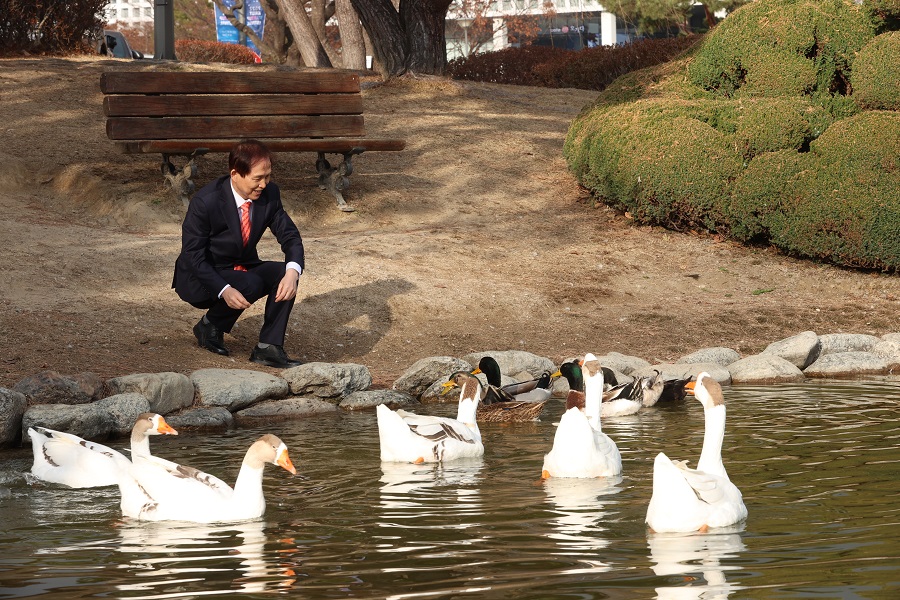people
In October of this year, KAIST signed an 'Agreement for the Training Program for AI Semiconductor Designers' with Samsung Electronics, to conduct joint research and actively nurture master's and doctorate researchers in the field of Semiconductors designed exclusively for AI devices. To celebrate this commemorative agreement for cooperation bound for mutual success, Samsung Electronics gifted a set of 5 ducks to KAIST.
The Duck Pond and the Geese have been representing KAIST as famous mascots.

It all started back in 2000, when the incumbent President, Professor Kwang Hyung Lee served was then a professor at the Department of Bio and Brain Engineering, he first picked up a pack of ducks from Yuseong Market and started taking care of it on campus around the Carillon pond. While the ducks came and went, eventually being replaced with a pack of geese over the time, for more than 20 years, the pack of feathery KAISTians stole the eyes of the passersby and were loved by both the on-campus members and the visitors, alike.
The representative of the Samsung Electronics said that the pack of ducks comprising of a new breed contains the message of SEC that it hopes that the PIM semiconductor technology will grow to become the super-gap technology that would turn heads and grab attention of the world as the mascot of Korea's technological prowess under the combined care of KAIST and SEC.
Would the ducks find KAIST likable? We will keep you informed of how they are doing!
-
research KAIST Develops Retinal Therapy to Restore Lost Vision
Vision is one of the most crucial human senses, yet over 300 million people worldwide are at risk of vision loss due to various retinal diseases. While recent advancements in retinal disease treatments have successfully slowed disease progression, no effective therapy has been developed to restore already lost vision—until now. KAIST researchers have successfully developed a novel drug to restore vision. < Photo 1. (From left) Ph.D. candidate Museong Kim, Professor Jin Woo Kim, a
2025-03-31 -
research KAIST provides a comprehensive resource on microbial cell factories for sustainable chemical production
In silico analysis of five industrial microorganisms identifies optimal strains and metabolic engineering strategies for producing 235 valuable chemicals Climate change and the depletion of fossil fuels have raised the global need for sustainable chemical production. In response to these environmental challenges, microbial cell factories are gaining attention as eco-friendly platforms for producing chemicals using renewable resources, while metabolic engineering technologies to enhance these
2025-03-27 -
research KAIST Captures Protein Reaction in Just Six Milliseconds
Understanding biomolecular processes - such as protein-protein interactions and enzyme-substrate reactions that occur on the microseconds to millisecond time scale is essential for comprehending life processes and advancing drug development. KAIST researchers have developed a method for freezing and analyzing biochemical reaction dynamics within a span of just a few milliseconds, marking a significant step forward in better understanding complex biological reactions. < Photo. (From left)
2025-03-24 -
research KAIST Develops Eco-Friendly, Nylon-Like Plastic Using Microorganisms
Poly(ester amide) amide is a next-generation material that combines the advantages of PET (polyester) and nylon (polyamide), two widely used plastics. However, it could only be produced from fossil fuels, which posed environmental concerns. Using microorganisms, KAIST researchers have successfully developed a new bio-based plastic to replace conventional plastic. KAIST (represented by President Kwang Hyung Lee) announced on the 20th of March that a research team led by Distinguished Professor
2025-03-24 -
research KAIST Captures Hot Holes: A Breakthrough in Light-to-Electricity Energy Conversion
When light interacts with metallic nanostructures, it instantaneously generates plasmonic hot carriers, which serve as key intermediates for converting optical energy into high-value energy sources such as electricity and chemical energy. Among these, hot holes play a crucial role in enhancing photoelectrochemical reactions. However, they thermally dissipate within picoseconds (trillionths of a second), making practical applications challenging. Now, a Korean research team has successfully devel
2025-03-17